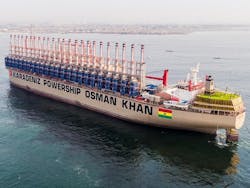'Floating Power Plant': CIRCOR Helps Shipyard Power Vessel Project
In designing a new powership for its global fleet of ‘floating power plants,’ Turkish company Karpowership needed an extensive shipset of 72 pumps, each capable of withstanding harsh marine conditions and continuous uptime. The company ultimately selected to source the entire shipset of pumps from the CIRCOR family of brands, which were able to specify and design the pumps to the ship’s rigorous demands. Once launched, the powership will supply continuous power production for remote, underserved areas of the world, and will be able to receive top-quality service from the pump manufacturer regardless of where it is anchored.
Floating Power Plants Take Shape
Karpowership is the owner, operator, and builder of the first fleet of powerships in the world. Powerships, which function as floating power plants, are emerging as an innovative way to supply power in remote locations. Currently in use across the Middle East, South Asia, and North Africa, the ships can be anchored along the coast where permanent power plants on land do not exist.
The power vessel resulting from this project is designed to produce energy using either liquid fuels (HFO/RFO) or natural gas, depending on availability and cost. That energy will then be supplied as electrical power in remote and developing areas of the world.
Though currently 1 in every 5 people globally has no access to electricity, Karpowership, with projects like this one, is capable of bringing electricity access to areas where such access was previously impossible. In order to do so, however, all equipment on the vessels must be capable of running continuously over extended periods of time.
When building a new powership in 2019, the company specified a shipset of 72 total pumps of several different varieties that would be necessary to make the project a success. Each of the ship’s 16 generators alone required a designated seawater cooling pump that could withstand the harsh, corrosive marine environment and stresses of functioning on a moving ship; all of the other pumps, a mix of centrifugal pumps, 3-screw pumps, PCP pumps, and two-screw pumps, would likewise need to be designed for the marine environment. What’s more, the powership, supplying high voltage power for onshore use, would need to be capable of running continuously in order to provide communities and businesses with uninterrupted power.
Faced with such a challenging pump shipset specification, Karpowership selected CIRCOR and its subsidiary brands ALLWEILER, IMO, and HOUTTUIN to provide all 72 of the necessary pumps, thanks to the company’s expertise in durable pumps and a wide range of pumping technology.
Pump Technology Critical To Power Generation
Over the span of approximately eight months, CIRCOR Allweiler has designed, built, supplied, and installed several different pump types critical to the functioning of the new powership. This includes sludge pumps in a screw pump design, heavy fuel oil transfer pumps in a two-screw pump design, primary and auxiliary seawater cooling pumps in a centrifugal pump design, and lube oil pumps in a three-screw pump design. The project will conclude in late 2020, at which point the vessel will begin to travel, supplying power to communities and businesses with few alternative power access options.
The first main challenge that CIRCOR needed to address was specifying the seawater cooling pumps. Though most ships only require 2-3 of such pumps, this one requires 16, all of which must be extremely large and heavy-duty. In the end, CIRCOR selected the MI-S 250-315, functioning at 1,100 m3/h.
The next and most significant challenge was to specify the ship’s seawater pump condensed steam turbines. Ultimately, CIRCOR’s latest generation of the MA-S 350-315 pump, functioning at 1,800 m3/h, was selected. These pumps were designed with a vertical axial intake and radial outlet; the initial technical specification indicated a vertical axial pump but extremely low NPSH value, which were difficult to achieve together. By introducing a radial outlet, the pump significantly reduces losses and keeps NPSH value low by eliminating the need for an elbow pipe before suction. This particular pump also features a unique, space-saving foot design that offers the pump stability even in heavy seagoing conditions. Additionally, the pump suction flange’s integrated fixing holes allow for pedestal mounting to the ship foundation. The bracket and foundation of the pump are specially designed for the confines of the vessel.
Finally, the third main challenge was to specify the Heavy Fuel Oil (HFO) transfer pump; CIRCOR ultimately selected its two-screw pump 236.118, which delivered the needed flow rates and NPSH value for the application.
Regardless of use, though, all of the pumps supplied to Karpowership are specifically designed for maximal uptime even in the harsh marine environment.
Benefits of a Single Pump Supplier
Beyond the technical expertise needed to select and deliver each of the individual necessary pumps, CIRCOR was selected for this project because it could supply the entire shipset of pumps from a single source and with a single service network. Thanks to the extensive expertise held within the CIRCOR family of brands, CIRCOR brands ALLWEILER, IMO, and HOUTTUIN were able to supply all of the highly reliable pumps needed in the extensive power vessel system, each specified to their particular application. The large, worldwide presence of CIRCOR also means that Karpowership can expect industry-leading service and support, regardless of where the powership is anchored.
Conclusion
The powership collaboration between CIRCOR and Karpowership is an ongoing one, as the project is due to be completed late in 2020. The extensive pump knowledge and manufacturing capacity held by CIRCOR’s family of brands means that Karpowership was able to specify an entire 72-pump shipset from a single supplier, to tailor each pump to its specific application within the ship, and to receive service and support throughout the world once the vessel is launched.
About the Author

